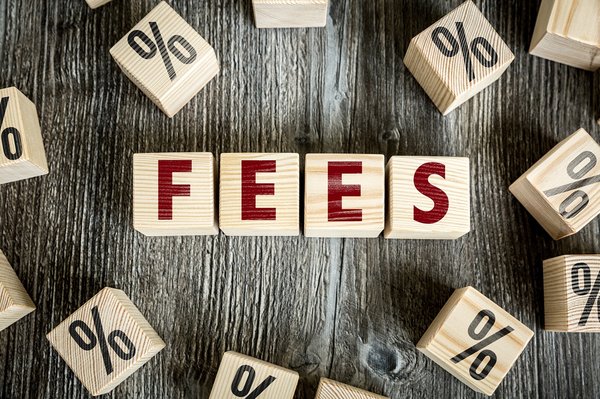Trading in cryptocurrencies will always come with some transaction fees. The crypto exchange you’re using probably charges some fees of its own, and you can’t get around the fee structures built into the cryptocurrencies themselves. But what are these fees, and how big can they get? Let’s have a look.

Image source: Getty Images.
What are they?
What are cryptocurrency transaction fees?
A transaction fee is a charge that is attached when you’re buying or selling something. As the saying goes, there’s no such thing as a free lunch. For cryptocurrencies, that means charging fees at a couple of different levels to keep the blockchain networks running and to incentivize the people providing transaction validation services.
The presence of fees also lowers the risk of pointless or harmful transactions overwhelming the cryptocurrency platforms. Any system for payments and data transfers without transaction fees would quickly be overwhelmed by spam.
Fees explained
Cryptocurrency transaction fees explained
These fees come in different varieties:
Crypto exchanges and trading services charge trading fees whenever you buy, sell, or exchange digital currencies on their platforms. This is a key moneymaking strategy for the exchanges on top of ancillary revenue streams, such as advertising, listing fees, and premium services.
Blockchain wallets that aren’t part of a crypto exchange’s standard service usually charge their own fees for each deposit or withdrawal. These fees typically support the wallet’s development and maintenance.
Every cryptocurrency has transaction fees built into its basic operating structure. They make the system less vulnerable to spam and denial of service attacks and usually play an important part in how the cryptocurrency rewards people for validating each transaction.
Bitcoin (CRYPTO:BTC) calls it a network fee, Ethereum (CRYPTO:ETH) transactions result in gas fees, and the Solana (CRYPTO:SOL) platform simply refers to processing costs as transaction fees.
Ethereum is a blockchain created in 2015 that is supported by a decentralized network of computers all over the world.
The costs are automatically baked into the transaction price, so they’re largely invisible to the buyer and seller. Still, you can rest assured that some additional value is changing hands behind the scenes. The names may vary, but they all boil down to the same idea of attaching a small expense to each transaction.
Network fees
How big are network fees?
Generally speaking, network fees tend to be small. For example, the median Bitcoin transaction moved approximately $2 million per trade in late 2024 and early 2025, and the median network fee over the same period was roughly $0.79. Bitcoin’s network fee amounts to a rounding error under most circumstances.
However, the fees can skyrocket when the blockchain network is unusually busy. For example, Ethereum’s gas fees skyrocketed to thousands of dollars per transaction in May 2022. Massive demand for a coveted series of Ethereum-based non-fungible tokens (NFTs) threw the network off-kilter for a few hours, and then the gas prices cooled down again.
As you can see, transaction fees are a crucial component of the business model for many different players in the crypto world. You can’t avoid these transaction fees entirely, but you can minimize them by choosing cryptocurrencies, trading services, and digital wallets with care.
These fees apply to every type of transaction, by the way. Whether you’re buying and selling cryptocurrencies in a trading exchange or sending coins from one account to another, the blockchain network will ask for a small payment.
Fee schedule
Cryptocurrency exchange fee schedule
The rules and fee structures for cryptocurrency transactions are unique to each trading platform. To highlight the common concepts and differences, let’s compare and contrast some of the most popular crypto exchanges.
Binance.us
Binance is the largest cryptocurrency trading platform in the world. It offers a few different trading methods, similar to a stock brokerage.
Transaction fees are higher for “takers,” who use market orders that fill immediately at the current market price. “Makers, on the other hand, rely on limit orders that set a specific target price and may take longer to execute but have a lower transaction fee. Makers provide liquidity for other traders, while takers consume assets from the same liquidity pool.
Binance’s transaction fees are based on your trading volume in the past 30 days and your transaction type. In January 2025, the classic pairing of Bitcoin and Tether (CRYPTO:USDC) is the only currency pair classified as “tier 0,” meaning you can trade between them in either direction without Binance fees.
In all other cases, here are the requirements and the effective trading fees for makers (limit orders) and takers (market orders):
|
Binance Level |
Minimum 30-Day Trade Volume |
Maker Fee |
Taker Fee |
|---|---|---|---|
|
VIP 1 |
$0 |
0.38% |
0.57% |
|
VIP 2 |
$50,000 |
0.2375% |
0.38% |
|
VIP 3 |
$100,000 |
0.1425% |
0.2375% |
|
VIP 4 |
$500,000 |
0.095% |
0.19% |
|
VIP 5 |
$1,000,000 |
0.076% |
0.171% |
|
VIP 6 |
$5,000,000 |
0.0475% |
0.1425% |
|
VIP 7 |
$10,000,000 |
0.019% |
0.095% |
|
VIP 8 |
$25,000,000 |
0% |
0.076% |
|
VIP 9 |
$100,000,000 |
0% |
0.0475% |
On top of this structure, Binance gives you a 5% discount on fees when you pay them from your BNB (BNB -1.28%) holdings. Let’s say you used Binance to trade a bit more than $10,000 of cryptocurrencies in the last 30 days. You’ll qualify for a $0.2375% maker fee or a 0.38% taker fee.
So, you place a $1,000 Binance trade for any cryptocurrency not named Bitcoin (or you pay for your Bitcoin using something other than the dollar-like Tether stablecoin). This will set you back $2.38 in transaction fees for a maker trade or $3.80 for a taker transaction.
Coinbase
Coinbase (COIN -6.01%) is one of the best-known crypto platforms in the U.S. Coinbase used to offer lower transaction fees for people with higher 30-day trading volumes, much like Binance, but that schedule has become a thing of the past. Instead, Coinbase will calculate a custom fee for every transaction on the platform’s standard trading tool.
According to Coinbase, factors that influence the fee include “your chosen payment method, order size, market conditions, jurisdictional location, asset, and other costs we incur to facilitate your transaction.” The effective trading price also usually includes a price spread of 1%, similar to the spreads you see when exchanging U.S. dollars for foreign currencies.
Here’s how these factors work with my personal Coinbase account on Jan. 14, 2025:
A $1,000 Bitcoin order would include a $10 price spread and an $18.40 Coinbase fee for a total fee load of $28.40. The fees and price spread did not change when I looked at various Bitcoin alternatives. However, the spread was higher and flat fees lower when exchanging one cryptocurrency for another — including the Tether stablecoin.
The basic Coinbase service tends to be a bit more costly than Binance and others. You can save a bit by using the Coinbase Advanced trading service, which charges fees but doesn’t include a price spread because you’re interacting more directly with the underlying blockchain networks.
The subscription-based Coinbase One service, on the other hand, skips the Coinbase fee but usually includes a price spread in each transaction. Coinbase is easy to use and packed with customer-friendly features, but you can find significantly lower transaction fees elsewhere.
Robinhood
The popular stockbroker Robinhood (HOOD -9.95%) also offers trading services for a handful of cryptocurrencies. The company says your crypto trades are commission-free on Robinhood, with a 0% fee for any type of order.
While Coinbase and Binance earn revenue and profits from their transaction fees, Robinhood makes money in other ways. First, it doesn’t actually execute crypto trades on its own. Instead, the company routes its incoming cryptocurrency orders to market makers in exchange for transaction rebates that are not passed on to the customer.
Crypto orders also are not executed at the current market price. Instead, you’ll buy crypto tokens from Robinhood at a slightly inflated price and sell them at a lower price. The difference between effective transaction prices and current quotes tends to sit near 0.6%, which is in the same zip code as the fees charged by Binance.
Low fees
Cryptocurrency exchanges with low transaction fees
You’ll never be able to avoid cryptocurrency transaction fees entirely, but you can choose to use services with lighter fee structures. Those fees can add up if you do a lot of trading in the crypto market.
Fee-free options include Robinhood, eToro, and BlockFi. The smaller services do include a 1% price spread, though. Exchanges such as BitMEX charge transaction fees below 0.1% for both makers and takers. However, as noted above, every trading service will make some money on your crypto orders.
The difference between the cheapest and most expensive option worked out to as much as 2% in some test runs, dropping down to a rounding error in other cases.
Related investing topics
Overall, smaller investors have more to gain from picking the right service than well-heeled traders do. Just as you should take care to stick with reputable, trustworthy cryptocurrencies, your trading platform should back up its affordable transaction fees with ironclad data security, powerful cryptocurrency screening tools, and an unshakeable financial platform.
While looking for the right combination of these crucial features, you should consider investing in safer asset classes such as stocks instead. When well-respected corporations dip their toes in the crypto opportunity, you can gain exposure to the same thrilling but dangerous market by investing in these companies instead.
FAQ
Cryptocurrency transaction fees FAQ
Are there transaction fees for cryptocurrency?
Every cryptocurrency transaction includes a small fee to keep the underlying blockchain network running. Most trading platforms also add transaction fees or price spreads to collect some revenues from each crypto trade.
Which cryptocurrency has the lowest transaction fees?
Some cryptocurrencies were designed to manage everyday transactions, similar to credit cards and cash. They tend to come with lower built-in fees and quicker transaction processing. Examples include Dogecoin (CRYPTO:DOGE), Litecoin (CRYPTO:LTC), and Ripple (CRYPTO:XRP).
Your choice of trading platform will probably make a bigger difference to your fees, though.
How do I avoid crypto transaction fees?
Due to the way blockchain networks function, every transaction will incur a small fee. There’s just no way around it.
To avoid exorbitant fees, like the gas-fee spike Ethereum experienced in 2022, you should double-check the included fees before finalizing any cryptocurrency transaction. You should also choose a crypto-trading service that fits your needs, balancing service features against flat fees and price spreads.







